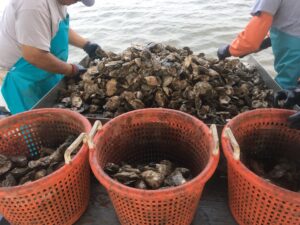 The National Oceanic and Atmospheric Administration has announced that it has recommended awarding $10 million to fund new reef construction for a Maryland Department of Natural Resources oyster sanctuary in the Chesapeake Bay.
The National Oceanic and Atmospheric Administration has announced that it has recommended awarding $10 million to fund new reef construction for a Maryland Department of Natural Resources oyster sanctuary in the Chesapeake Bay.
The four-year grant will provide infrastructure funding for building reef bases on about 50 to 75 acres within an existing oyster sanctuary, as well as ground-truthing to assess the area before construction.
NOAA awarded the funding as part of its Transformational Habitat Restoration and Coastal Resilience Projects under the Bipartisan Infrastructure Law and Inflation Reduction Act.
“This is an exciting time for oysters in the Chesapeake Bay,” Maryland Department of Natural Resources Secretary Josh Kurtz said. “Just as we’re finishing the tributary phase of sanctuary construction and seeding, this $10 million award will help us with future oyster restoration throughout Maryland.”
The construction will be part of a new project at one of several proposed sanctuaries. The Maryland Department of Natural Resources identified several possible sites, which will be presented at the August 19 meeting of the Oyster Advisory Commission to receive stakeholder feedback on the sites.
The grant comes as the Chesapeake Bay Program’s 2014 Chesapeake Bay Watershed Agreement hits its 10th anniversary. The agreement outlined a goal to restore oyster habitat and populations in 10 tributaries—five each in Maryland and Virginia—by 2025.
According to this summer’s Chesapeake Bay Oyster Restoration Update for 2023, four of Maryland’s five large-scale oyster sanctuaries are initially complete, and work on the last site in Manokin River is well underway and scheduled to be complete on target in 2025. Harris Creek, the first Maryland sanctuary to be targeted, is now considered fully and successfully restored.
Maryland now has more than 1,000 acres of restored oyster reefs, which is equivalent to 1.5 square miles or more than 800 football fields. Last year, the state had record-setting oyster spat plantings and an outstanding natural spatset.
The eastern oyster, the species found in the Bay, is a keystone species. Oyster reefs provide important habitat for Bay fish and crustaceans, and oysters serve as natural filters that remove excess nutrients. Scientists estimate that adult oysters can filter more than 10 gallons per day in the Chesapeake Bay.
Oysters are also an economic driver for the region. In the 2021-2022 and 2022-2023 oyster harvest seasons, Maryland oystermen have brought in dockside values of $21.5 million and $31 million, respectively, a result of two years with the highest landfall of oysters since 1987.


